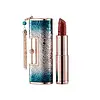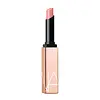What's inside
What's inside
 Key Ingredients
Key Ingredients

 Benefits
Benefits

 Concerns
Concerns

 Ingredients Side-by-side
Ingredients Side-by-side

Isononyl Isononanoate
EmollientPolyglyceryl-2 Triisostearate
EmulsifyingSilica
AbrasiveButylene Glycol Dicaprylate/Dicaprate
EmollientDiethylhexyl Carbonate
EmollientIsoeicosane
EmollientOctyldodecanol
EmollientLauroyl Lysine
Skin ConditioningSynthetic Fluorphlogopite
Synthetic Wax
AbrasivePolyethylene
AbrasiveEuphorbia Cerifera Wax
Hydrogenated Vegetable Oil
EmollientSucrose Tetrastearate Triacetate
EmollientPolybutene
Polymethylsilsesquioxane
Diglyceryl Sebacate/Isopalmitate
EmollientDipentaerythrityl Tetrahydroxystearate/Tetraisostearate
Skin ConditioningVp/Hexadecene Copolymer
Dicalcium Phosphate
AbrasiveCandelilla Wax Esters
Diisostearyl Malate
EmollientPolyhydroxystearic Acid
EmulsifyingPolyglyceryl-2 Diisostearate
EmulsifyingCaprylyl Glycol
EmollientGlyceryl Caprylate
EmollientCopernicia Cerifera Wax
Ethylhexyl Palmitate
EmollientIsopropyl Myristate
EmollientIsostearic Acid
CleansingLecithin
EmollientPaeonia Suffruticosa Seed Oil
EmollientSimmondsia Chinensis Seed Oil
EmollientPolyglyceryl-3 Polyricinoleate
EmulsifyingDimethicone
EmollientTriethoxycaprylylsilane
Silica Dimethyl Silylate
EmollientTocopherol
AntioxidantCI 15985
Cosmetic ColorantCI 16035
Cosmetic ColorantCI 77492
Cosmetic ColorantCI 77499
Cosmetic ColorantCI 77491
Cosmetic ColorantCI 15850
Cosmetic ColorantIsononyl Isononanoate, Polyglyceryl-2 Triisostearate, Silica, Butylene Glycol Dicaprylate/Dicaprate, Diethylhexyl Carbonate, Isoeicosane, Octyldodecanol, Lauroyl Lysine, Synthetic Fluorphlogopite, Synthetic Wax, Polyethylene, Euphorbia Cerifera Wax, Hydrogenated Vegetable Oil, Sucrose Tetrastearate Triacetate, Polybutene, Polymethylsilsesquioxane, Diglyceryl Sebacate/Isopalmitate, Dipentaerythrityl Tetrahydroxystearate/Tetraisostearate, Vp/Hexadecene Copolymer, Dicalcium Phosphate, Candelilla Wax Esters, Diisostearyl Malate, Polyhydroxystearic Acid, Polyglyceryl-2 Diisostearate, Caprylyl Glycol, Glyceryl Caprylate, Copernicia Cerifera Wax, Ethylhexyl Palmitate, Isopropyl Myristate, Isostearic Acid, Lecithin, Paeonia Suffruticosa Seed Oil, Simmondsia Chinensis Seed Oil, Polyglyceryl-3 Polyricinoleate, Dimethicone, Triethoxycaprylylsilane, Silica Dimethyl Silylate, Tocopherol, CI 15985, CI 16035, CI 77492, CI 77499, CI 77491, CI 15850
Tridecyl Trimellitate
EmollientHydrogenated Polyisobutene
EmollientPhenylpropyldimethylsiloxysilicate
EmollientSynthetic Wax
AbrasiveMica
Cosmetic ColorantRicinus Communis Seed Oil
MaskingHydrogenated Vegetable Oil
EmollientPolyethylene
AbrasiveDiisostearyl Malate
EmollientDiglyceryl Sebacate/Isopalmitate
EmollientDimethicone
EmollientDicalcium Phosphate
AbrasivePhytosteryl/Isostearyl/Cetyl/Stearyl/Behenyl Dimer Dilinoleate
Skin ConditioningGardenia Taitensis Flower Extract
Skin ConditioningMoringa Oleifera Seed Extract
Skin ConditioningPolyhydroxystearic Acid
EmulsifyingIsopropyl Myristate
EmollientIsostearic Acid
CleansingEthylhexyl Palmitate
EmollientLecithin
EmollientPolyglyceryl-3 Polyricinoleate
EmulsifyingTriethoxycaprylylsilane
Polysilicone-11
Butyrospermum Parkii Butter
Skin ConditioningEthylene/Propylene Copolymer
AbrasivePentaerythrityl Tetra-Di-T-Butyl Hydroxyhydrocinnamate
AntioxidantTocopherol
AntioxidantWater
Skin ConditioningCollagen
MoisturisingLeuconostoc/Radish Root Ferment Filtrate
AntimicrobialHydrogenated Coco-Glycerides
EmollientSodium Hyaluronate
HumectantHydrogenated Castor Oil
EmollientTocopheryl Acetate
AntioxidantCocos Nucifera Oil
MaskingSimmondsia Chinensis Seed Oil
EmollientMangifera Indica Seed Butter
Skin ConditioningOlea Europaea Fruit Oil
MaskingCaprylyl Glycol
EmollientGlyceryl Caprylate
EmollientGlycerin
HumectantIron Oxides
CI 15850
Cosmetic ColorantCI 77891
Cosmetic ColorantCI 19140
Cosmetic ColorantTridecyl Trimellitate, Hydrogenated Polyisobutene, Phenylpropyldimethylsiloxysilicate, Synthetic Wax, Mica, Ricinus Communis Seed Oil, Hydrogenated Vegetable Oil, Polyethylene, Diisostearyl Malate, Diglyceryl Sebacate/Isopalmitate, Dimethicone, Dicalcium Phosphate, Phytosteryl/Isostearyl/Cetyl/Stearyl/Behenyl Dimer Dilinoleate, Gardenia Taitensis Flower Extract, Moringa Oleifera Seed Extract, Polyhydroxystearic Acid, Isopropyl Myristate, Isostearic Acid, Ethylhexyl Palmitate, Lecithin, Polyglyceryl-3 Polyricinoleate, Triethoxycaprylylsilane, Polysilicone-11, Butyrospermum Parkii Butter, Ethylene/Propylene Copolymer, Pentaerythrityl Tetra-Di-T-Butyl Hydroxyhydrocinnamate, Tocopherol, Water, Collagen, Leuconostoc/Radish Root Ferment Filtrate, Hydrogenated Coco-Glycerides, Sodium Hyaluronate, Hydrogenated Castor Oil, Tocopheryl Acetate, Cocos Nucifera Oil, Simmondsia Chinensis Seed Oil, Mangifera Indica Seed Butter, Olea Europaea Fruit Oil, Caprylyl Glycol, Glyceryl Caprylate, Glycerin, Iron Oxides, CI 15850, CI 77891, CI 19140
Ingredients Explained
These ingredients are found in both products.
Ingredients higher up in an ingredient list are typically present in a larger amount.
Caprylyl Glycol is a humectant and emollient, meaning it attracts and preserves moisture.
It is a common ingredient in many products, especially those designed to hydrate skin. The primary benefits are retaining moisture, skin softening, and promoting a healthy skin barrier.
Though Caprylyl Glycol is an alcohol derived from fatty acids, it is not the kind that can dry out skin.
This ingredient is also used as a preservative to extend the life of products. It has slight antimicrobial properties.
Learn more about Caprylyl GlycolCi 15850 is the pigment color red. It is an azo dye and created synthetically.
Azo dyes need to be thoroughly purified before use. This allows them to be more stable and longer-lasting.
This ingredient is common in foundations, lipsticks, and blushes. This color is described as brown/orangey red.
It has many secondary names such as Red 6 and Red 7. According to a manufacturer, Red 6 usually contains aluminum.
Learn more about CI 15850Dicalcium Phosphate is an exfoliant.
We don't have a description for Diglyceryl Sebacate/Isopalmitate yet.
Diisostearyl Malate is an emollient and most often used in lip products. It comes from isostearyl alcohol, a fatty acid, and malic acid, an AHA.
As an emollient, Diisostearyl Malate helps create a thin film on your skin to trap moisture in. This helps keep your skin soft and smooth.
Dimethicone is a type of synthetic silicone created from natural materials such as quartz.
What it does:
Dimethicone comes in different viscosities:
Depending on the viscosity, dimethicone has different properties.
Ingredients lists don't always show which type is used, so we recommend reaching out to the brand if you have questions about the viscosity.
This ingredient is unlikely to cause irritation because it does not get absorbed into skin. However, people with silicone allergies should be careful about using this ingredient.
Note: Dimethicone may contribute to pilling. This is because it is not oil or water soluble, so pilling may occur when layered with products. When mixed with heavy oils in a formula, the outcome is also quite greasy.
Learn more about DimethiconeEthylhexyl Palmitate, also known as octyl palmitate, is created from 2-ethylhexyl alcohol and palmitic acid. It is a fatty acid ester.
The fatty acid content of Ethylhexyl Palmitate makes it an emollient. Emollients help soften and hydrate your skin by trapping moisture within.
Ethylhexyl Palmitate is also used to help improve the texture of cosmetics. It helps other ingredient dissolve in products and help disperse ingredients more evenly.
You'll likely find this ingredient in sunscreen, as it is often used to mix UV-blocking ingredients such as avobenzone and ethylhexyl triazone.
It can also help stabilize the fragrances in a product as a fragrance fixative.
Ethylhexyl Palmitate can be used to substitute mineral oil.
Due to its high fatty acid content, it may not be fungal-acne safe.
Learn more about Ethylhexyl PalmitateGlyceryl Caprylate comes from glycerin and caprylic acid, a fatty acid from coconut. It has emollient and emulsifier properties.
As an emollient, it helps hydrate your skin. Emollients work by creating a barrier on your skin to trap moisture in, helping to keep your skin soft and smooth.
On the other hand, emulsifiers prevent ingredients (such as oil and water) from separating.
Learn more about Glyceryl CaprylateHydrogenated Vegetable Oil is created by adding hydrogen to vegetable oil in order to give it more stability. This process also raises the melting point of vegetable oil. In cosmetics, it is an emollient.
Emollients help soothe and soften the skin. They do this by creating a protective film on your skin. This barrier helps trap moisture and keeps your skin hydrated. Emollients may be effective at treating dry or itchy skin.
The term "Hydrogenated Vegetable Oil" is an umbrella term and can refer to a variety of vegetable oils and blends of: sunflower oil, soybean oil, olive oil, coconut oil, palm oil, and more.
Due to the differences in vegetables, the benefits may vary.
Learn more about Hydrogenated Vegetable OilIsopropyl Myristate is an emollient, thickening agent, and texture enhancer. It is created from isopropyl alcohol and myristic acid.
It is used to help other ingredients be better absorbed. It is also an emollient and may help soften and hydrate the skin.
The comedogenic rating of this ingredient depends on the concentration. Lower amounts results in a lower rating.
Isopropyl Myristate may not be fungal acne safe. It can potentially worsen acne prone skin.
Learn more about Isopropyl MyristateIsostearic acid is a saturated fatty acid. Its structure makes it a great surfactant.
Surfactants help decrease the surface tension between two liquids. This property also makes it an effective emulsifier. Emulsifiers help prevent waters and oils from separating in a product.
Isostearic Acid is created from oleic acid.
This ingredient may not be Malassezia folliculitis, or fungal-acne safe.
Learn more about Isostearic AcidLecithin is a term for a group of substances found in the cell membranes of plants, animals, and humans. They are made up of mixture of phospholipids.
This ingredient has emollient and emulsifying properties.
As an emollient, lecithen helps soften the skin and creates a barrier to keep moisture in.
As an emulsifier, it also helps prevent water and oil ingredients from separating. Lecithin can also help ingredients be better absorbed by the skin.
This is because the phospholipids in lecithin produce liposomes. Liposomes help other ingredients get through the skin barrier.
Depending on the source of this ingredient, lecithin may not be fungal acne safe. This is because some sources of lecithin come from soybean oil, which may feed the malassezia yeast that feeds fungal acne.
We recommend reaching out to the brand you are purchasing from to inquire about the source of their lecithin.
Some other names for this ingredient include soy lecithin and deoiled soy lecithin.
Learn more about LecithinPolyethylene is a synthetic ingredient that helps the skin retain moisture. It is a polymer.
It is also typically used within product formulations to help bind solid ingredients together and thicken oil-based ingredients. When added to balms and emulsions, it helps increase the melting point temperature.
This ingredient is an emulsifier. It is created from Polyglycerin-3 and Ricinoleic Acid.
As an emulsifier, it prevents waters and oils from separating. According to a manufacturer this ingredient is fully biodegradable.
This ingredient may not be safe for Malassezia folliculitis due to its Ricinoleic Acid base. Ricinoleic Acid is a fatty acid derived from castor oil.
Learn more about Polyglyceryl-3 PolyricinoleatePolyhydroxystearic Acid is a soft wax made from castor oil.
It is is a texture thickener, emulsifier, and film-former. Emulsifiers prevent ingredients from separating, such as oils and waters.
Polyhydroxystearic Acid may not be fungal acne safe.
Learn more about Polyhydroxystearic AcidThis oil comes from the seeds of the desert shrub called Jojoba. It is more commonly known as jojoba oil, a non-comedogenic oil.
Jojoba oil does not contain fragrance and has many fatty-acids, making it a great soothing ingredient.
It also contains Vitamin E, a great moisturizing ingredient. Vitamin E is also an antioxidant and protects your skin against oxidative damage.
This ingredient humectant properties, meaning it helps draw moisture from the air. This helps keep your skin hydrated.
While jojoba has antibacterial properties, it is only able to kill some strains of bacteria.
Studies also show it helps in wound healing. In fact, Indigenous cultures have used jojoba as a moisturizer and to help treat burns for centuries.
Fun fact: Jojoba oil similar to natural human skin sebum, so it has a great effect on dry skin. It is also promising with helping to regulate sebum production.
Due to its fatty acid content, Jojoba oil may not be fungal acne safe. We recommend speaking with a professional if you have any concerns.
Learn more about Simmondsia Chinensis Seed OilSynthetic Wax is created from fossil fuels such as natural gas. It is used to enhance texture, adjust pH, and as an occlusive.
It may also be used as an abrasive ingredient to exfoliate the skin.
Synthetic Wax may not be fungal acne safe.
Learn more about Synthetic WaxTocopherol (also known as Vitamin E) is a common antioxidant used to help protect the skin from free-radicals and strengthen the skin barrier. It's also fat soluble - this means our skin is great at absorbing it.
Vitamin E also helps keep your natural skin lipids healthy. Your lipid skin barrier naturally consists of lipids, ceramides, and fatty acids. Vitamin E offers extra protection for your skin’s lipid barrier, keeping your skin healthy and nourished.
Another benefit is a bit of UV protection. Vitamin E helps reduce the damage caused by UVB rays. (It should not replace your sunscreen). Combining it with Vitamin C can decrease sunburned cells and hyperpigmentation after UV exposure.
You might have noticed Vitamin E + C often paired together. This is because it is great at stabilizing Vitamin C. Using the two together helps increase the effectiveness of both ingredients.
There are often claims that Vitamin E can reduce/prevent scarring, but these claims haven't been confirmed by scientific research.
Learn more about TocopherolTriethoxycaprylylsilane is a silicone used to bind and stabilize ingredients.
As an emulsifier, it helps prevent ingredients from separating. This can help elongate the shelf life of products.
Triethoxycaprylylsilane is often used to coat mineral sunscreens ingredients to help give a better feel. It also helps reduce oxidative stress in sunscreens.
Learn more about Triethoxycaprylylsilane